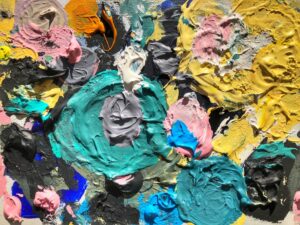In this article, you will explore the fascinating world of synaesthetic art and how this discipline can enrich your sensory experience. You will discover how synaesthetic artworks stimulate not only sight, but also hearing, touch and other sensations, creating a unique multi-sensory interaction. We will explore the ways in which these art forms can influence your perceptions and well-being. Get ready to discover new horizons of sensory experience and understand the role of art in your daily life.
Definition of synesthetic art
Synesthetic art is an artistic experience that involves several senses at once, creating a unique interaction between sight, hearing, touch and sometimes even smell and taste. Through works that stimulate different perceptions, this art form aims to transcend the traditional boundaries of sensory perception, allowing you to explore a new way of experiencing and understanding art itself, amplifying the emotions and sensations it can evoke.
Origins and history
The origins of synaesthetic art date back to 20th century art movements such as Futurism and Cubism, which sought to break with traditional conventions of artistic expression. Artists such as Wassily Kandinsky and Paul Klee were pioneers in seeking connections between colours and sounds, paving the way for a profound exploration of the links between different sensory experiences. Since then, the concept has evolved, influencing various contemporary art forms.
Famous examples of synaesthetic art
Famous examples of synaesthetic art include works by artists such as Kandinsky and composer John Cage, whose work combined music and visuals. Other examples include immersive installations such as those by Olafur Eliasson, where light and environment create a multi-sensory experience. These artists and their works offer you a unique experience, making your gut and mind interact through different senses.
A representative example is Kandinsky’s ‘The Concert of Synesthesia’, which combines abstract forms and vibrant colours to evoke an emotional response similar to that which music induces in the listener. In the contemporary sphere, Eliasson’s installations invite the public to explore environments where light, water and spaces are designed to awaken a synaesthetic response, offering an experience where the boundary between the senses dissolves, inviting you to reflect on how we perceive the world.
Synesthesia in sensory experiences
Synesthesia is a unique condition that unites the senses in unexpected ways, enriching your sensory experiences. When you perceive a sound and at the same time see a colour or taste a shape, synesthesia amplifies your reality, allowing you to explore deeper connections between emotions and sensations. You will discover how this fusion can intensify the way you experience and interpret the world around you.
How synesthesia influences the senses
If you are synaesthetic, you will notice how your senses interact with each other in unconventional ways. A sound can evoke a taste or smell, and these combined sensory experiences can influence your mood and perception of a situation. This interaction not only enriches your daily life, but also offers unique perspectives in understanding sensory experiences.
The impact on aesthetic experience
Synesthesia plays a fundamental role in your aesthetic experience, making art and music more engaging. Through synesthesia, musical tones can evoke vivid colours, while visual images can evoke emotions that translate into tactile experiences. This synergy between senses gives rise to an artistic dimension that transcends individual sensory modalities.
The impact of synesthesia on aesthetic experience manifests itself in many forms, from works of art to concerts. When you interact with art, your synesthetic perceptions enrich every detail, transforming a simple painting into a multi-sensory experience. Emotions are amplified, creating a deeper and more lasting connection with the artwork. Experiencing art through the eyes and ears, or even touch, allows creativity to flourish, evoking feelings and memories that might otherwise remain hidden. In essence, synesthesia not only enriches your aesthetic experiences, but also invites you to explore and re-evaluate the interconnected beauty of the world.
Interaction between art and sensory perception
When you explore synesthetic art, you realise how art and sensory perception intertwine in surprising ways. This interaction invites you to engage your senses in an active dialogue, allowing for a deeper, more immersive experience. Your perception is amplified, transforming simple observation into a multisensory experience.
Techniques used by the artists
Synaesthetic artists use different techniques to stimulate the audience’s senses. You may find the use of vibrant colours, harmonious sounds and evocative texts all designed to awaken your emotions and perceptions. These techniques aim to create a fusion of sight, hearing and touch, facilitating a more intense connection with the artwork.
How the audience reacts
When interacting with synesthetic art, your reaction is often characterised by intense emotions and personal reflections. The experience can vary greatly from person to person, allowing you to explore your inner self and discover new dimensions of your perception. Art thus becomes a medium through which you explore not only the work itself, but also yourself, amplifying your sensory awareness.
The reactions of the audience are crucial to understanding the power of synaesthetic art. When confronted with these works, you may feel a wave of emotions that can range from joy to nostalgia. The interactivity of synesthetic art stimulates deep reflection, prompting you to question how sensations and perceptions influence the way you see the world. This emotional connection makes the art experience unique and memorable, turning your participation into an exploratory and revelatory journey.
Psychological and philosophical implications
Synesthetic art offers a fascinating insight into the psychological and philosophical implications of our sensory experience. It invites you to consider how your senses interact with each other and influence your perception of reality. Through this art form, you can explore how emotions and memories are linked to sensory experiences, thus enriching your understanding of the world.
Understanding the world through the senses
Through your senses, you gain vital information about your surroundings. Synesthetic art, in particular, stimulates a combination of sensations that can offer a more complex and profound view of reality. This multidimensionality allows you to grasp nuances and details that would otherwise escape you.
Relationship between art and cognition
The relationship between art and cognition is fundamental to understanding how synesthetic art influences the way you think and feel. When you immerse yourself in an artistic experience involving several senses, you activate different areas of your brain and cognitive stimuli. This process, in many cases, can expand your creativity and improve your problem-solving skills, highlighting the importance of artistic experiences in your daily life.
In particular, art stimulates your mind to process information in unique ways. Synaesthetic experiences can activate associations between images, sounds and words, enriching your critical thinking. These synaesthetic connections help you not only better understand works of art, but also develop a more nuanced view of the world, enhancing your capacity for social and communicative interaction.
Synaesthesia in popular culture
Synesthesia has found a place in popular culture, influencing visual arts, literature and performance. Many artists and writers have sought to capture and convey the synesthetic experience through their works, allowing you, as a viewer, to explore a world where the senses intertwine and enrich each other.
Representations in the media
In today’s media, synesthesia is often used to create unique and engaging atmospheres. Films, photographs and music videos use colours and sounds to evoke emotions, inviting you to experience sensations beyond the visible and audible.
Synesthesia and music
Music represents one of the most fascinating forms of synesthesia, as sounds can evoke colours and shapes. For you, this sensory interaction can turn listening into a multi-sensory experience, where melodies and harmonies combine with unique visualisations in your mind.
When listening to a piece of music, you may perceive vivid colours and shapes dancing in synchrony with the melodies. Some composers and musicians, such as Olivier Messiaen and Pharrell Williams, have claimed to have synaesthetic experiences, translating these impressions into works that stir deep emotions. Synesthesia in music is not just a personal phenomenon, but a bridge that allows all of you to feel connected on deeper levels, where notes are transformed into visual landscapes and emotions manifest in vibrant colours.
Future of synaesthetic art
The future of synaesthetic art is promising and exciting as the possibilities for creative exploration expand. New generations of artists are increasingly interested in combining the senses, creating works that are not only seen, but heard and felt. Your curiosity and openness to multisensory experiences will enrich the cultural landscape, offering new perspectives on how we perceive the world around us.
Technological innovations
Technological innovations are revolutionising synaesthetic art, enabling immersive and interactive experiences. Tools such as augmented and virtual reality offer you the chance to interact with art in ways never seen before, stimulating not only sight, but also hearing and touch. This combination of technology and creativity paves the way for new forms of artistic expression.
New forms of artistic expression
New forms of artistic expression emerging from synesthetic art combine different disciplines and mediums, allowing you to explore the beauty of synesthesia in innovative ways. Contemporary artists are creating installations that involve sights, sounds and even smells to offer a complete sensory experience. These works tend to break through the traditional boundaries of art, inviting you to actively participate and interpret art according to your personal sensations. Art becomes an interactive journey, where your experience plays a key role in giving the work deep meaning.
What does synaesthetic art reveal about our sensory experience?
In conclusion, synaesthetic art invites you to explore the complexity of your sensory experience by stimulating a deep connection between the various senses. Through this art form, you can discover how emotions and perceptions intertwine, offering new dimensions of understanding. It allows you to broaden your horizons, making your experience of the world richer and more nuanced. In this way, synaesthetic art not only enriches your life, but also encourages you to appreciate the uniqueness of your perceptions.



